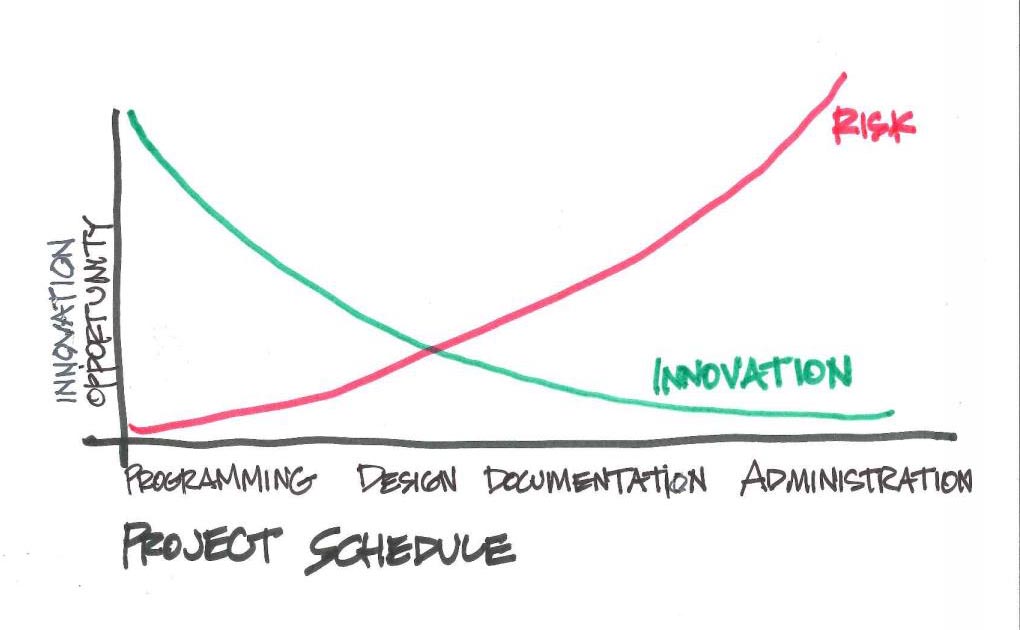The Cost of Innovation
Like you, I’m in the business of creativity, of innovation. My clients expect innovation from me. They may engage my firm to reposition an existing property, to create a new brand, but mostly they want a positive shift in their business.
As designers, we search for areas, methods, and places to create new and exciting innovations, and that exploration and work has brought me to an unexpected realization. There are in fact better times to innovate than others. What does this mean to you the hotel owner or operator? This means that if you know the best times for high-level creativity, for game-changing thinking, for blue sky conceptual thinking, then you can seriously leverage that creativity and thinking and not risk making changes at the wrong time which adversely impact your project.
Historically, I’ve introduced new ideas and new thinking at every conceivable point over the arc of a project. From early on in the design phases (which is the norm), from within the construction documents phase and even within the construction administration phase. My best clients do the same thing. They push and search for innovation under every rock. I’d love to give you a great counter example, but looking back over 30 years in this industry, I truly can’t think of a single example when a late-stage innovation has in fact made a significant improvement on a project. Late stage innovations have always come with a high price. Let me explain where and why.
That’s because there’s an inverse relationship between Risk and Innovation. In the very earliest point of a project, the Programming Phase, even prior to the Conceptual or Schematic Design Phases, very few variables are known or have been determined. By definition, this is the time in the project when the Big 3 (schedule, budget and quality) are being determined, developed and vetted. This is where the scope and breadth of the project gets hammered out. In the best of circumstances, this effort is done with all stakeholders on board and done in a collaborative way. This is the very best place for figuring out just how far, just how much the boundaries get pushed or redefined in terms of innovation.
In this pre-design phase, the overall project risk is also at its minimum. The budget, if determined and known, typically hasn’t been spent (though some money has been committed such as consultant fees, primarily). The Schedule, if determined, has just been roughly estimated. Included in the early schedule draft hopefully are milestone dates, the completion and opening dates and heads-on-bed dates. But the time itself hasn’t been expended, never to be recaptured. These two variables, budget and schedule, are the determining drivers for assessing the potential of whether or not innovation can safely occur or be initiated and subsequently accepted.
In graphic form this dynamic looks like this.

Innovation opportunity is at its highest early on because ideas at that point is free and easy because they haven’t been worked out. But notice, as time progresses, more and more freedom is lost, less and less opportunity for significant innovation exists. Inversely, Risk in the early stages is at its lowest. As more time is expended, more resources are committed, and more money has been spent and likely to be considered gone and irreplaceable.
So where do you as an owner have the best chance of maximizing your innovative opportunity and its effectiveness? Early. Best case scenario - before the design even starts.
If you structure your project so you and your team do your big thinking up front, you’ll have the greatest opportunity to direct your resources accurately and with maximum effectiveness.
Innovation in and of itself is a somewhat polarizing concept. Either you need it, want it and will commit to it, or you considered it an impedance to your business model for one reason or another.
But if innovation is what you want, then the timing of it is really important. Partly for some of you, this is just a discipline issue because you’re wanting to keep your foot on the gas and improve at every possible juncture. For others, who have de-emphasized innovation for whatever reason, careful management of the timing just might make the pursuit of innovation less risky and more palatable.
I have been on both project types: the one in which innovation continues until heads on beds, and the one in which we are actually discouraged from innovation because the property isn't important in the portfolio or there is a low expectation or standard. Both of these have a monetary and a psychic cost; in the first scenario, the team is worn to a frazzle, but the end product is truly remarkable. In the second scenario, the team is uninspired, and we always know the property could have performed better, but no one cared. In the final analysis, neither of these paths is necessary. Innovation with the right timing is a no-cost benefit.



